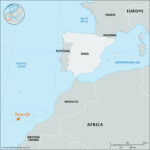Nestled in the heart of the Balkans, North Macedonia is a country brimming with historical significance and natural beauty. For those asking “Where Is Macedonia Country?”, the answer lies in Southeast Europe, a region known for its complex past and vibrant cultures. This article delves into the geographical location of North Macedonia, explores its rich history spanning millennia, and clarifies its place in the modern world.
Geographical Location of North Macedonia
North Macedonia is situated in the central Balkan Peninsula, a region historically recognized as a crossroads between Eastern and Western civilizations. It occupies a crucial geographical position, bordering several countries:
- To the North: Serbia and Kosovo
- To the East: Bulgaria
- To the South: Greece
- To the West: Albania
This landlocked nation is strategically positioned within the Balkan Peninsula, historically known as a melting pot of cultures and empires. Its location has profoundly shaped its history, making it a bridge and sometimes a battleground between different powers.
Balkan Peninsula Context
To understand “where is Macedonia country” more fully, it’s essential to grasp its Balkan context. The Balkan Peninsula is a region in Southeast Europe named after the Balkan Mountains. It’s characterized by diverse geography, including mountains, rivers, and fertile plains, contributing to its rich biodiversity and varied agricultural potential. North Macedonia benefits from this diverse landscape, boasting stunning mountains and lakes, such as Lake Ohrid, one of the oldest and deepest lakes in Europe, and a UNESCO World Heritage site.
Neighboring Countries and Regional Significance
North Macedonia’s neighbors have played significant roles in its history and continue to influence its present. Its proximity to Greece to the south is particularly noteworthy due to historical and political reasons, including the long-standing name dispute which will be discussed further. Bulgaria to the east shares linguistic and historical ties, while Serbia to the north was part of the same Yugoslav federation for much of the 20th century. Albania to the west adds another layer to the cultural mosaic of the region, with significant Albanian populations within North Macedonia itself. This location makes North Macedonia a key player in Balkan regional dynamics and European geopolitics.
A Journey Through Macedonian History
Understanding “where is Macedonia country” also requires exploring its long and storied past. The region has been inhabited for millennia, witnessing the rise and fall of numerous civilizations.
Ancient Roots and Classical Era
The area now known as North Macedonia has been a cradle of civilization for over 10,000 years. It was home to Neolithic farmers and various ancient peoples including Paeonians, Illyrians, and Thracians. However, it rose to prominence with the Ancient Macedonians. In 357 BC, Philip II of Macedon, father of Alexander the Great, conquered the region, integrating it into the powerful Macedonian Kingdom. This kingdom extended far beyond modern-day North Macedonia, playing a pivotal role in shaping the ancient world. After the Roman conquest in 145 BC, Macedonia became a Roman province, further solidifying its position as a significant region within vast empires.
Medieval Period and Ottoman Rule
Following the division of the Roman Empire in 395 AD, the region became part of the Eastern Roman, or Byzantine, Empire. The arrival of Slavic tribes in the 7th century AD dramatically altered the cultural and ethnic landscape. In the 9th century, it was incorporated into the Bulgarian Empire, with Ohrid becoming a significant capital and ecclesiastical center. Byzantium regained control in 1018, and for centuries, the region was contested between Byzantines, Bulgarians, and Serbians. The late 14th century marked another turning point with the Ottoman Empire’s expansion into the Balkans. Macedonia became part of the Ottoman Empire, remaining under Ottoman control for over five centuries, which deeply influenced its cultural and societal development.
20th Century and Independence
The decline of the Ottoman Empire in the late 19th and early 20th centuries led to significant changes in the Balkans. The Treaty of San Stefano in 1878 initially ceded North Macedonia to Bulgaria, but the Great Powers intervened, returning it to the Ottoman Empire. This period saw the rise of Macedonian nationalism and struggles for independence, including the Ilinden Uprising in 1903. The Balkan Wars of 1912 and 1913 resulted in the division of Macedonia among Bulgaria, Greece, and Serbia. After World War I, the region corresponding to today’s North Macedonia became part of the Kingdom of Serbs, Croats and Slovenes, later Yugoslavia. During World War II, it was occupied by Axis powers. In 1944, it became a constituent republic within socialist Yugoslavia, known as the Socialist Republic of Macedonia. Following the breakup of Yugoslavia, North Macedonia declared independence on September 8, 1991, marking a new chapter in its history.
The “North Macedonia” Name and Modern Identity
The quest to understand “where is Macedonia country” in the present day cannot be complete without addressing the name dispute with Greece. Upon independence, the newly formed nation adopted the name Republic of Macedonia. However, Greece objected to this name, arguing it implied territorial claims to the northern Greek region of Macedonia. This led to a protracted and complex diplomatic standoff.
Due to Greek objections, North Macedonia was admitted to the United Nations in 1993 under the provisional name “Former Yugoslav Republic of Macedonia” (FYROM). The name dispute significantly impacted the country’s international relations and aspirations for EU and NATO membership. After years of negotiations, a resolution was reached with the Prespa Agreement in 2018, resulting in the country officially changing its name to the Republic of North Macedonia. This agreement paved the way for closer integration with Euro-Atlantic institutions and resolved a significant obstacle in its international path.
Today, North Macedonia is navigating its path as an independent nation, striving for economic development, democratic consolidation, and integration into the European Union. Understanding “where is Macedonia country” is not just about pinpointing its location on a map, but also about appreciating its rich historical tapestry, its complex regional dynamics, and its ongoing journey of nation-building in the 21st century.
For further exploration of North Macedonia, you can visit these resources:

